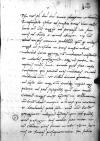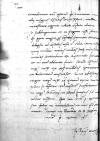Proficiscente isthuc ad Royal Prussia (Prussia Regalis), region, part of Prussia annexed to the Kingdom of Poland in 1466 under the provisions of the Second Peace of Thorn⌊Prussiae terrasRoyal Prussia (Prussia Regalis), region, part of Prussia annexed to the Kingdom of Poland in 1466 under the provisions of the Second Peace of Thorn⌋ hoc tabellario cum litteris regiis, non permisi, ut sine meis ad Vestram Dominationem Reverendissimam abiret. Cui nihil aliud in praesens occurrit scribendum, quam quod milites regii... illegible⌈...... illegible⌉, ad praesidia in terris Rus (Russia)⌊RussiaeRus (Russia)⌋ relicti, Duchy of Moldavia (Valachia, Hospodarstwo Mołdawskie), country between the eastern Carpathians, the Dniester and the Danube delta, from 1456 a fiefdom of Turkey, where Polish and Turkish influences clashed in the 15th-16th centuries. The Latin name Valachia was widely used in Poland at the time to describe Moldavia, and not the Duchy of Wallachia, which was further south⌊ValachiamDuchy of Moldavia (Valachia, Hospodarstwo Mołdawskie), country between the eastern Carpathians, the Dniester and the Danube delta, from 1456 a fiefdom of Turkey, where Polish and Turkish influences clashed in the 15th-16th centuries. The Latin name Valachia was widely used in Poland at the time to describe Moldavia, and not the Duchy of Wallachia, which was further south⌋ ferro igneque non mediocriter vastarunt et The Valachs ⌊ValachosThe Valachs ⌋ profligarunt, atque cum praeda et captivis reversi sunt. Deinde quid fiet, nescio. Consulunt, qui peritiam artis militaris et notam Duchy of Moldavia (Valachia, Hospodarstwo Mołdawskie), country between the eastern Carpathians, the Dniester and the Danube delta, from 1456 a fiefdom of Turkey, where Polish and Turkish influences clashed in the 15th-16th centuries. The Latin name Valachia was widely used in Poland at the time to describe Moldavia, and not the Duchy of Wallachia, which was further south⌊MoldaviamDuchy of Moldavia (Valachia, Hospodarstwo Mołdawskie), country between the eastern Carpathians, the Dniester and the Danube delta, from 1456 a fiefdom of Turkey, where Polish and Turkish influences clashed in the 15th-16th centuries. The Latin name Valachia was widely used in Poland at the time to describe Moldavia, and not the Duchy of Wallachia, which was further south⌋ habent, ut bellum hieme geratur cum hoste hoc, neque enim faciliori negotio cogi poterit ad pacem suscipiendam, quam hoc modo.
Ceterum Ferdinand I of Habsburg (*1503 – †1564), from 1521 Archduke of Austria, from 1526 King of Bohemia and Hungary, Croatia and Slavonia as Ferdinand I, 1531-1558 King of the Romans, 1558-1564 Holy Roman Emperor; son of Philip I the Handsome and Joanna the Mad of Castile, a younger brother of Charles V of Habsburg⌊regis RomanorumFerdinand I of Habsburg (*1503 – †1564), from 1521 Archduke of Austria, from 1526 King of Bohemia and Hungary, Croatia and Slavonia as Ferdinand I, 1531-1558 King of the Romans, 1558-1564 Holy Roman Emperor; son of Philip I the Handsome and Joanna the Mad of Castile, a younger brother of Charles V of Habsburg⌋ exercitus in Slavonia, region in southeastern Europe, subordinated to the Kingdom of Croatia⌊SchlavoniaSlavonia, region in southeastern Europe, subordinated to the Kingdom of Croatia⌋ non levem cladem accepit a The Ottoman Turks (Turcae) ⌊TurcisThe Ottoman Turks (Turcae) ⌋, qui victoria et bombardis potiti sunt, etiam nunc dicuntur expugnare reliquum exercitus, qui ad quandam arcem perfugit. Res accidit satis mira, ut cum Christiani omnibus ferme in rebus essent superiores et The Ottoman Turks (Turcae) ⌊TurcosThe Ottoman Turks (Turcae) ⌋ persequerentur, ita subito  BCz, 247, p. 310 conciderint animi ipsorum, quod Hans Katzianer (*1490 – †1539)⌊CacianerHans Katzianer (*1490 – †1539)⌋ et alii insignes exercitus Ferdinand I of Habsburg (*1503 – †1564), from 1521 Archduke of Austria, from 1526 King of Bohemia and Hungary, Croatia and Slavonia as Ferdinand I, 1531-1558 King of the Romans, 1558-1564 Holy Roman Emperor; son of Philip I the Handsome and Joanna the Mad of Castile, a younger brother of Charles V of Habsburg⌊regis superinscribed⌈regisregis superinscribed⌉ RomanorumFerdinand I of Habsburg (*1503 – †1564), from 1521 Archduke of Austria, from 1526 King of Bohemia and Hungary, Croatia and Slavonia as Ferdinand I, 1531-1558 King of the Romans, 1558-1564 Holy Roman Emperor; son of Philip I the Handsome and Joanna the Mad of Castile, a younger brother of Charles V of Habsburg⌋ praefecti, nulla necessitate cogente, relicto exercitu clam se subduxerint et in fugam versi sunt, quos postea magna pars exercitus secuta, hincinde hidden by binding⌈[de]de hidden by binding⌉ dilapsa ab hostibus caesa est, alia item, nempe XIIII milia, unius militis Itali cuiusdem comitis fortitudine et dexteritate servata hidden by binding⌈[a]a hidden by binding⌉ et in arcem abducta fuit. Ferunt exercitum Ferdinand I of Habsburg (*1503 – †1564), from 1521 Archduke of Austria, from 1526 King of Bohemia and Hungary, Croatia and Slavonia as Ferdinand I, 1531-1558 King of the Romans, 1558-1564 Holy Roman Emperor; son of Philip I the Handsome and Joanna the Mad of Castile, a younger brother of Charles V of Habsburg⌊regis RomanorumFerdinand I of Habsburg (*1503 – †1564), from 1521 Archduke of Austria, from 1526 King of Bohemia and Hungary, Croatia and Slavonia as Ferdinand I, 1531-1558 King of the Romans, 1558-1564 Holy Roman Emperor; son of Philip I the Handsome and Joanna the Mad of Castile, a younger brother of Charles V of Habsburg⌋ ex XX-ti milibus Germanorum et Bohemorum constitisse. Quae adversitas coegit Ferdinand I of Habsburg (*1503 – †1564), from 1521 Archduke of Austria, from 1526 King of Bohemia and Hungary, Croatia and Slavonia as Ferdinand I, 1531-1558 King of the Romans, 1558-1564 Holy Roman Emperor; son of Philip I the Handsome and Joanna the Mad of Castile, a younger brother of Charles V of Habsburg⌊regem RomanorumFerdinand I of Habsburg (*1503 – †1564), from 1521 Archduke of Austria, from 1526 King of Bohemia and Hungary, Croatia and Slavonia as Ferdinand I, 1531-1558 King of the Romans, 1558-1564 Holy Roman Emperor; son of Philip I the Handsome and Joanna the Mad of Castile, a younger brother of Charles V of Habsburg⌋ ad Graz, city in southwest Austria, situated on both sides of the Mur river, the capital city of Styria⌊GraciumGraz, city in southwest Austria, situated on both sides of the Mur river, the capital city of Styria⌋, Styria (Stiria, Herzogtum Steiermark), duchy in eastcentral Europe, today in southern Austria (Bundesland Steiermark) and northeastern Slovenia⌊StyriaeStyria (Stiria, Herzogtum Steiermark), duchy in eastcentral Europe, today in southern Austria (Bundesland Steiermark) and northeastern Slovenia⌋ metropolim, se conferre et nostram profectionem in negotio matrimonii in aliud tempus, sed incognitum hidden by binding⌈[ognitum]ognitum hidden by binding⌉(?) adhuc, transferre.
BCz, 247, p. 310 conciderint animi ipsorum, quod Hans Katzianer (*1490 – †1539)⌊CacianerHans Katzianer (*1490 – †1539)⌋ et alii insignes exercitus Ferdinand I of Habsburg (*1503 – †1564), from 1521 Archduke of Austria, from 1526 King of Bohemia and Hungary, Croatia and Slavonia as Ferdinand I, 1531-1558 King of the Romans, 1558-1564 Holy Roman Emperor; son of Philip I the Handsome and Joanna the Mad of Castile, a younger brother of Charles V of Habsburg⌊regis superinscribed⌈regisregis superinscribed⌉ RomanorumFerdinand I of Habsburg (*1503 – †1564), from 1521 Archduke of Austria, from 1526 King of Bohemia and Hungary, Croatia and Slavonia as Ferdinand I, 1531-1558 King of the Romans, 1558-1564 Holy Roman Emperor; son of Philip I the Handsome and Joanna the Mad of Castile, a younger brother of Charles V of Habsburg⌋ praefecti, nulla necessitate cogente, relicto exercitu clam se subduxerint et in fugam versi sunt, quos postea magna pars exercitus secuta, hincinde hidden by binding⌈[de]de hidden by binding⌉ dilapsa ab hostibus caesa est, alia item, nempe XIIII milia, unius militis Itali cuiusdem comitis fortitudine et dexteritate servata hidden by binding⌈[a]a hidden by binding⌉ et in arcem abducta fuit. Ferunt exercitum Ferdinand I of Habsburg (*1503 – †1564), from 1521 Archduke of Austria, from 1526 King of Bohemia and Hungary, Croatia and Slavonia as Ferdinand I, 1531-1558 King of the Romans, 1558-1564 Holy Roman Emperor; son of Philip I the Handsome and Joanna the Mad of Castile, a younger brother of Charles V of Habsburg⌊regis RomanorumFerdinand I of Habsburg (*1503 – †1564), from 1521 Archduke of Austria, from 1526 King of Bohemia and Hungary, Croatia and Slavonia as Ferdinand I, 1531-1558 King of the Romans, 1558-1564 Holy Roman Emperor; son of Philip I the Handsome and Joanna the Mad of Castile, a younger brother of Charles V of Habsburg⌋ ex XX-ti milibus Germanorum et Bohemorum constitisse. Quae adversitas coegit Ferdinand I of Habsburg (*1503 – †1564), from 1521 Archduke of Austria, from 1526 King of Bohemia and Hungary, Croatia and Slavonia as Ferdinand I, 1531-1558 King of the Romans, 1558-1564 Holy Roman Emperor; son of Philip I the Handsome and Joanna the Mad of Castile, a younger brother of Charles V of Habsburg⌊regem RomanorumFerdinand I of Habsburg (*1503 – †1564), from 1521 Archduke of Austria, from 1526 King of Bohemia and Hungary, Croatia and Slavonia as Ferdinand I, 1531-1558 King of the Romans, 1558-1564 Holy Roman Emperor; son of Philip I the Handsome and Joanna the Mad of Castile, a younger brother of Charles V of Habsburg⌋ ad Graz, city in southwest Austria, situated on both sides of the Mur river, the capital city of Styria⌊GraciumGraz, city in southwest Austria, situated on both sides of the Mur river, the capital city of Styria⌋, Styria (Stiria, Herzogtum Steiermark), duchy in eastcentral Europe, today in southern Austria (Bundesland Steiermark) and northeastern Slovenia⌊StyriaeStyria (Stiria, Herzogtum Steiermark), duchy in eastcentral Europe, today in southern Austria (Bundesland Steiermark) and northeastern Slovenia⌋ metropolim, se conferre et nostram profectionem in negotio matrimonii in aliud tempus, sed incognitum hidden by binding⌈[ognitum]ognitum hidden by binding⌉(?) adhuc, transferre.
Opto, ut Vestra Paternitas Reverendissima sit felix et incolumis et me, quod facit hidden by binding⌈[t]t hidden by binding⌉, amet.
 BCz, 247, p. 310 conciderint animi ipsorum, quod
BCz, 247, p. 310 conciderint animi ipsorum, quod 

